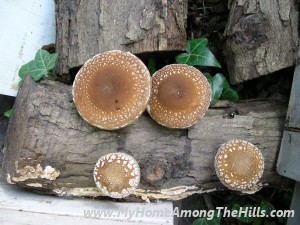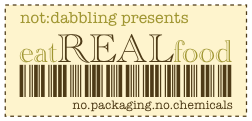Posted in Gardening, tagged Mushrooms on October 29, 2009|
10 Comments »
I have always loved mushrooms. When I was a kid, my Grandpa got one of those “Grow Your Own Mushrooms” kits in the mail. The terra cotta pot in which they were to be grown was shaped like a mushroom and had that funky sort of look that everything in the 70s had. Now grandpa had no intention of growing the “special 70s mushrooms”, but his setup would have made one wonder. Anyhow, he wanted a handful of button mushrooms so he set up the kit and did everything he was instructed to do…but he got no mushrooms.

I always figured that since Grandpa couldn’t grow mushrooms, it must not be possible by the common man. I settled for buying mushrooms at the grocery store and ordering extra mushrooms on my pizzas. But there is just something not quite right about store bought mushrooms compared to fresh ones…sort of like everything.

Fast forward a few years to present. I found a friend that also loves mushrooms and has been growing her own for years. We talked some and it turns out that it is incredibly simple to grow mushrooms.
First, you’ll need to order mushroom spawn from a reputable online source. One of the best sources is probably Fungi Perfecti. They have all sorts of spawn that can be purchased so pick what you like. I grow Shiitake. Anyhow, once you get your spawn (it will be a container of sawdust which contains the spawn), you’ll need a few logs cut to lengths about 3-4 feet. Hardwood logs are best for Shiitakes so I got white oak logs approximately 4-6 inches in diameter.

Using a 3/4 spade bit, I drilled tons of holes in each log. I spaced them 6 inches or so apart across the entire surface of the log (I also burned up a drill doing this so don’t push too hard and take breaks!). In each hole, I packed the inoculated sawdust and sealed each hole with melted beeswax. I have bees so beeswax is easy for me to get, but you can also any food-grade wax to seal the holes.
The logs should be thrown out back and ignored for about a year. I set my logs on bricks to keep them out of the dirt. You can set them upright or lay them down in a stack. Make sure that the logs get plenty of rain and absolutely no attention whatsoever. If all goes well and the stars align properly, you’ll have mushrooms in a year (actually, I don’t think it is that complicated). Logs of the size I mentioned should fruit for several years if you give them the proper amount of inattention!
I’ll post again later about what to do with the abundance of mushrooms you’ll get when your logs fruit. You’ll probably have more than you can use so you’ll need a plan. Stay tuned for more b.s. (it’s mushroom food afterall!) in a few weeks!
Warren can also be found at My Home Among the Hills writing about the adventures of life in WV.
Read Full Post »






























